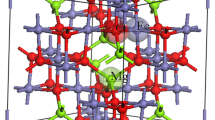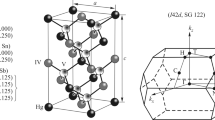Abstract
An unrestricted Hartree-Fock (UHF) approach has been developed by Kunz and his coworkers1,2,3 to study the optical excitation properties of atomic, molecular, and solid-state systems and the results have been sufficiently satisfactory4. In the present study, three computational models are used to simulate the sulphur-doped magnesium oxide (MgO). The first model is the seven-ion cluster (S-6Mg): one sulphur ion at the center with six nearest magnesium ions. The second one is the same cluster plus some surrounding ions considered as point charges at the sites of the nuclei. The third is the one used in “Ionic Crystal with Electronic Cluster, Automatic Program” (ICECAP)5. In this model, the (S-6Mg) cluster is embedded in a shell-model lattice. The ions in this lattice are taken as dipole polarizable point charges coupled harmonically to uniformly charged massless spherical shells. The interactions among the ions are in terms of the Coulomb and short-range potentials. In fact, ICECAP is developed especially for determining the defect properties of crystalline materials arising from excess electrons, holes, or impurities in the crystal. A detailed description of this program package will be given by A.B. Kunz at this conference.
Access this chapter
Tax calculation will be finalised at checkout
Purchases are for personal use only
Similar content being viewed by others
References
A.B. Kunz and D.L. Klein, Phys. Rev. B17:4614 (1978).
A.B. Kunz and P.W. Goalwin, Phys. Rev. B34:2140 (1986).
A.B. Kunz and J.M. Vail, Phys. Rev. B38:1058 (1988).
For example, S.T. Pantelides, D.J. Mickish, and A.B. Kunz, Solid State Comm., 15:203–205 (1974); A.B. Kunz and P.W. Goalwin, Phys. Rev., B34:2140 (1986); A.B. Kunz, J. Meng, and J.M. Vail, Phys. Rev., B38:1064 (1988); A.B. Kunz and R. Pandey, Phys. Rev., in press.
J.H. Harding, A.H. Harker, P.B. Keegstra, R. Pandey, J.M. Vail, and C. Woodward, Physica, 131B:151 (1985).
R. Pandey and J.M. Vail, J. Phys: Condensed Matter, in press (1989).
S. Huzinaga, “Gaussian Basis Sets for Molecular Calculations”, Elsevier, New York, 1984.
D.M. Roessler and W.C. Walker, Phys. Rev. Lett., 17:31 (1966); Phys. Rev., 159, 733 (1967).
Author information
Authors and Affiliations
Editor information
Editors and Affiliations
Rights and permissions
Copyright information
© 1989 Plenum Press, New York
About this chapter
Cite this chapter
Zuo, J., Pandey, R., Kunz, A.B. (1989). Simulation of Isovalent Impurities in Magnesium Oxide Using Hartree-Fock Clusters. In: Vitek, V., Srolovitz, D.J. (eds) Atomistic Simulation of Materials. Springer, Boston, MA. https://doi.org/10.1007/978-1-4684-5703-2_3
Download citation
DOI: https://doi.org/10.1007/978-1-4684-5703-2_3
Publisher Name: Springer, Boston, MA
Print ISBN: 978-1-4684-5705-6
Online ISBN: 978-1-4684-5703-2
eBook Packages: Springer Book Archive




